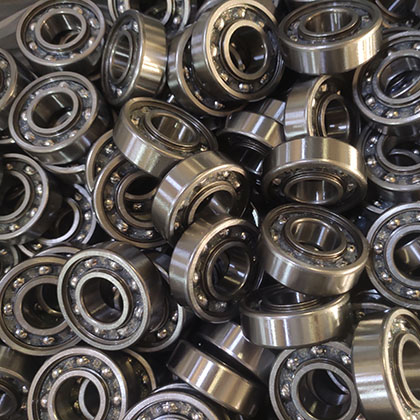
Ball bearing dimensions
Ball bearings come in various dimensions and sizes to accommodate different applications and loads. The dimensions of a ball bearing are typically specified by the inner diameter (ID), outer diameter (OD), and width or height (W) of the bearing. The dimensions are commonly expressed in millimeters (mm) or inches.
Inner Diameter (ID):
This is the measurement of the bore or the inside diameter of the bearing, indicating the size of the shaft that the bearing will fit onto.
Width (W):
This is the measurement of the width or height of the bearing, indicating how thick the bearing is. In some cases, it might be referred to as the “B” dimension.
Outer Diameter (OD):
This is the measurement of the outside diameter of the bearing, indicating the size of the housing or structure that will contain the bearing.
For instance, a bearing labeled “20mm x 47mm x 14mm” would mean that it has an inner diameter of 20mm, an outer diameter of 47mm, and a width of 14mm.
Several other factors are important considerations when specifying or selecting ball bearings:
Load Capacity:
Bearings must be chosen based on their ability to handle radial and axial loads. The load capacity is influenced by factors such as the size and number of balls, as well as the quality of materials and manufacturing processes.
Speed Rating:
Bearings are designed to operate within certain speed limits. Exceeding these limits can lead to increased friction, heat generation, and premature wear. Speed ratings are crucial for selecting the right bearing for a particular application.
Material:
The choice of materials for the inner and outer rings, as well as the balls and cage, depends on factors like temperature, corrosion resistance, and load requirements. Common materials include chrome steel, stainless steel, and ceramic.
Lubrication:
Proper lubrication is critical for minimizing friction, reducing wear, and ensuring efficient operation. Bearings may come pre-lubricated or require additional lubrication based on the application.
Precision Class:
Bearings are available in different precision classes, ranging from standard to precision and high-precision classes. The level of precision required depends on the application’s demands for accuracy and smooth operation.
Environmental Conditions:
Consideration of factors such as temperature, humidity, and exposure to chemicals or abrasive substances is vital to choosing a bearing that will perform reliably in a given environment.
Seals and Shields:
Bearings may have seals or shields to protect against contamination and retain lubrication. The choice between these options depends on the specific environmental conditions the bearing will be exposed to.
Cage Type:
The cage, which separates and retains the balls, can be made of various materials, including steel, brass, or engineered plastics. The cage design influences factors like heat generation, lubrication distribution, and overall bearing performance.
Installation and Tolerance:
Proper installation practices are essential to prevent misalignment and ensure the bearing’s longevity. Bearings are manufactured with specific tolerance levels, and adherence to these tolerances during installation is crucial.
NSAR, a professional deep groove ball bearings supplier in China, provides a broad variety of deep groove ball bearing with best customer service and quality assured. With more than 20 years deep groove ball bearings manufacture experience, our deep groove ball bearing has been exported to United States, Canada, Mexico, Brazil, Argentina. you can products download,NSAR can satisfy your bulk deep groove ball bearing customization needs,We provide 6012 bearing and 6000 bearings series and 6200 bearings series and pillow block ball bearings and 6300 bearing,

